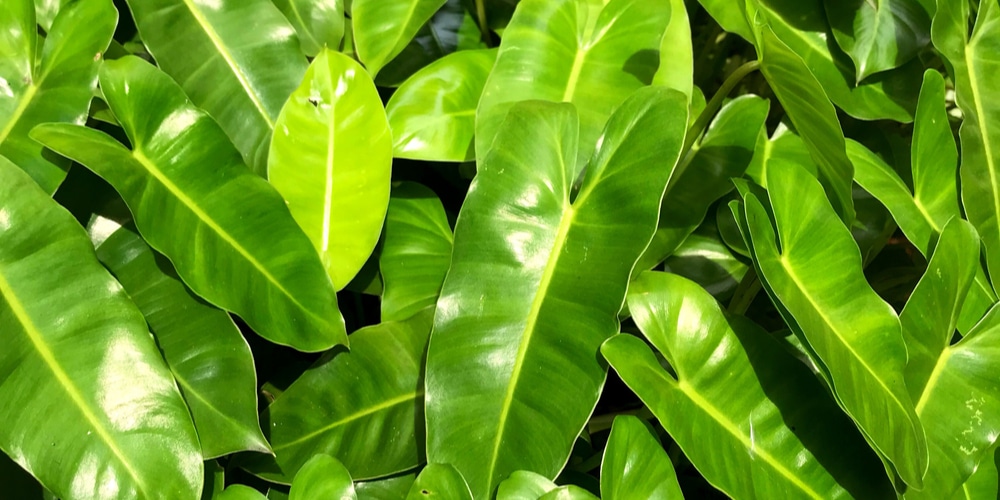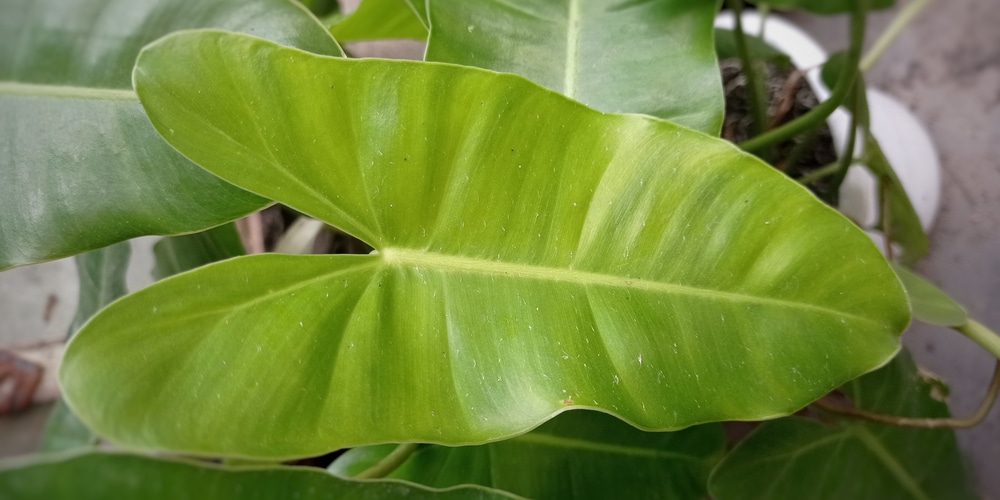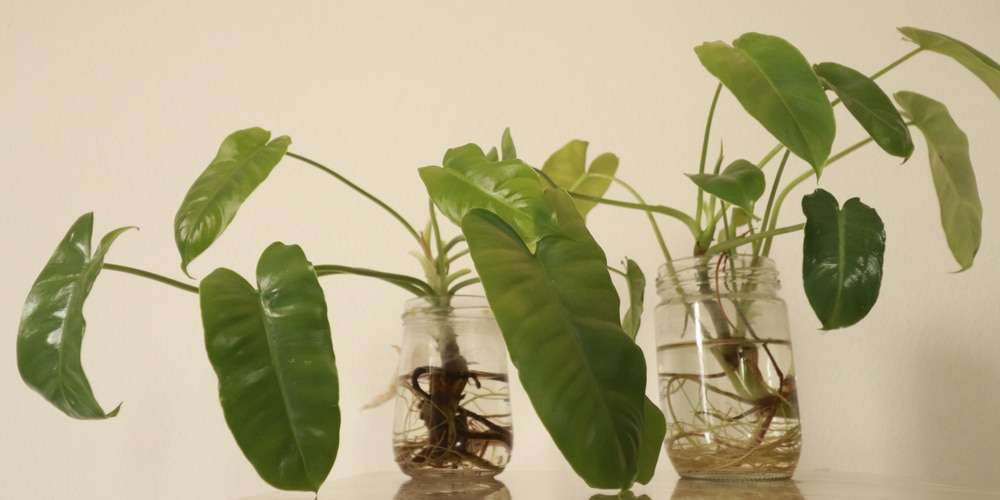An indoor jungle or tropical garden is not complete without a philodendron plant. They make great ornamental plants that you can display in your room or anywhere inside your house to create a more relaxing space. Philodendrons are known to purify the air. Their large leaves absorb harmful gases and release oxygen into the air. Philodendron domesticum is another philodendron plant that deserves a spot in your collection. This plant features stunning leaves that are long and shaped like a spade. The plant is easy to care for and easy to propagate. Here is everything you need to know about Philodendron domesticum.
Philodendron Domesticum Quick Facts

- Botanical Name: Philodendron Domesticum
- Common Name: Spade Leaf Philodendron, Burgundy Philodendron
- Plant Type: Perennial
- Flower Color: Rare to bloom as a houseplant, but in its natural habitat, it is possible to witness the leaf-like spathe that encloses the white spadix
- Size When Mature: 8 feet
- Bloom Time: May to July, once the plant reaches maturity, which takes 15 years
- Sun Requirements: Medium to bright, indirect light
- USDA Hardiness Zone: 9 to 11
- Soil PH Range: 5 to 6 pH
- Soil Type: Loose, well-drained, rich in organic matter
- Water Needs: Medium
- Native Area: South America
What You Need to Know About Philodendron Domesticum
Philodendron domesticum is an evergreen perennial vine native to South America. Tropical jungles or humid rainforests are the natural habitats of this plant. Most Philodendron domesticum are grown indoors as houseplants because they don’t do well in cold climates. What can you expect? This plant originally lived in warm and humid environments, but not under direct sunlight. They grow under the shade of tall trees in the forest. Indoors, you can easily provide the temperature that this plant wants. They also give off a jungle vibe, making your house look more lively.
Just like most philodendron plants, Philodendron domesticum features stunning foliage. This is actually one way to distinguish the plant from its other relatives. The leaves are also heart-shaped but elongated, making them look more like spades or arrows. They are green in color and have a glossy texture. The plant is actually called “Spade Leaf Philodendron” because of its unique leaf shape. The stem appears slightly purple. This is why Philodendron domesticum is also called Burgundy Philodendron.
The plant can grow up to 8 feet tall. Mature plants have leaves that measure up to 22 inches long and 9 inches wide. Philodendron domesticum is not known for its flowers. In fact, it is rare to see the plant bloom indoors. You can witness the plant bloom in its natural habitat, but you only see flowers in plants that have already lived for 15 years or more. Yes! It takes decades for philodendrons to blossom. Aside from that, the flowers only bloom for 2 days during their blooming time, which is May to July. Philodendron domesticum is very low maintenance, making it easy to grow and care for. When you grow it indoors, be sure to keep it away from pets or children because the plant is poisonous.
How to Care for Philodendron Domesticum
The best way to care for a Philodendron domesticum is to know its natural habitat. When you provide the plant with a growing environment that is similar to its habitat in the rainforest of tropical America, the plant will thrive anywhere you plant it. Most Philodendron domesticum plants are grown indoors in containers or hanging pots. This way, you can easily relocate the plant to an area where it will most likely survive. Here is everything you need to know about growing and caring for a thriving Philodendron domesticum plant.
Light
Philodendron domesticum thrives most when it receives bright, indirect light. Remember that its natural habitat is under the shade of tall trees, where it receives plenty of light but is shaded from direct sunlight. Do not place the plant in direct sunlight as the scorching heat will burn the leaves, especially if you live in an area with hot summers. On the other hand, too little light can slow growth. Don’t worry if your place can only offer medium light, for this plant can tolerate low light environments. But if you want the plant to grow at its best, bright light is needed. Of course, this would mean more water and more maintenance since the plant is fast-growing under bright lights.
Water and Soil Needs
Philodendron domesticum can suffer greatly from overwatering as this can lead to root rot. Underwatering is also not desirable, especially in the summer when the soil dries up too fast. Water more in the growing season and less in the autumn and winter. The best way to know if the plant needs watering is to check the top 2 inches of the soil. If it’s dry, then water the plant thoroughly. To avoid the roots from being soaked in water, you need a well-drained soil type for Philodendron domesticum. The soil also must be loose, rich in organic matter, and slightly acidic, which is somewhere between 5 and 6 pH.
Temperature Requirements
Philodendron domesticum thrives in USDA hardiness zones 9 to 11. Coming from a warm growing environment, it can only survive winter temperatures that do not go lower than 20 degrees F. If you live in zones 9 to 11, you can easily grow the plant outdoors, but make sure to choose a planting location that is shaded from the sun. If you live in an area with cold winters, then it would be best to grow the plant indoors. The ideal temperature for Philodendron domesticum is between 55 and 80 degrees F. Keep the plant away from open doors and windows, heaters, and air conditioners because it doesn’t like extreme and fluctuating temperatures. The plant also requires humidity levels above 40%.
Fertilizer
The plant can greatly benefit from a bit of fertilizer, especially during the growing season. The fertilizer can help the plant grow and produce more healthy leaves. The best fertilizer to use on a Philodendron domesticum plant is a liquid fertilizer that also has magnesium and calcium to prevent pale-looking leaves. Apply fertilizer to the plant every 2 to 4 weeks during the spring and summer. The plant doesn’t need feeding at times when it is not actively growing, which is in autumn and winter. If you still want to continue feeding, you can just do it once every 2 months.
Common Diseases
Since the foliage is the greatest asset of Philodendron domesticum, you might want to protect it from mealybugs and aphids. You can use insecticidal soap or neem oil to get rid of these harmful insects from your plant. Root rot, mildew, and leaf spot can also occur, but when you provide an ample amount of water to the plant, this will not be a problem. Oftentimes, these diseases are caused by overwatering. When you just provide the right growing conditions for the Philodendron Domesticum plant, it will grow healthy, free of pests and diseases.
Philodendron Domesticum Propagation
Propagating Philodendron Domesticum is easy, and you can do this in a jar of water or in potting soil. Cut a stem with at least one leaf node and then remove the lower leaves. When you put the cutting in a jar of water, it will allow you to easily see its root development. Place the jar in a place where it can receive bright, indirect light.
The roots will appear after two weeks. When the roots become an inch long, it is time to transplant the cutting to its permanent pot. If you want to put the cutting in a pot with potting soil, dip first the end part of the cutting in a rooting hormone so that the roots will develop quickly.
How to Prune Philodendron Domesticum
Pruning is done when you spot dying, discolored, or decayed leaves on the Philodendron domesticum plant. Trimming can also encourage growth and can help your plant look more pleasing to the eyes. Wear gloves before you touch the plant, as it can cause skin irritation. Use sterile and sharp scissors to avoid infection and make the job easy for you. Cut brown leaves as close as possible to the base. You can also trim the plant to control its shape, like removing the lower leaves to give the plant a tree-like appearance.

